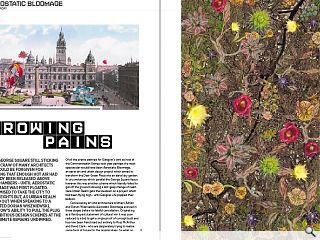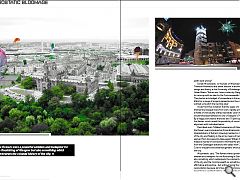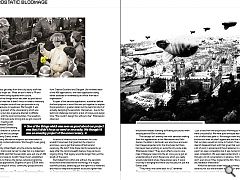Aerostatic Bloomage
13 Jan 2014
With George Square still sticking in the craw of many architects you could be forgiven for thinking that enough hot air had already been released above City Chambers - until Aerostatic Bloomage was first floated. It promised to take the city to new heights but, as Urban Realm found out when speaking to a deflated Dorian Wiszniewski, Glasgow’s ability to pull the plug on ambitious design schemes at the last minute remains undimmed.
Of all the events planned for Glasgow’s stint as host of the Commonwealth Games next year perhaps the most spectacular would have been Aerostatic Bloomage, an aerial art and urban design project which aimed to transform the Dear Green Place into an aerial sky garden. In circumstances which parallel the George Square fiasco however this was another scheme which literally failed to get off the ground following a last-gasp change of heart. Here Urban Realm gets the lowdown on a project which had been flying high… until Glasgow Life popped their balloon.Conceived by art and architecture brothers Adrian and Dorian Wiszniewski Aerostatic Bloomage evolved in three stages before its fateful cancellation; Originating as a flamboyant statement of cultural vim it was soon reduced to a bid to get a single proof of concept built and has now been franchised out entirely to Ross McArthur and David Clark - who are desperately trying to realise some form of future for the original ideas. So what on earth went wrong?
Dorian Wiszniewski, co-founder of Wiszniewski Thomson Architects and senior lecturer in architectural design and theory at the University of Edinburgh, told Urban Realm: “Adrian and I were invited by Glasgow Life to come up with an idea for the Commonwealth Games. They had an arts budget of somewhere in the region of £14m for a range of projects spread across the city and wanted us to pitch the next big idea.”
It was from this invitation that the seeds of a floral-themed sky bouquet were first sown, rapidly growing to a flotilla of individually crafted ‘aerostats’ each of which would have been tethered to one of Glasgow’s 74 parks. By a happy coincidence there are also 70 participants in the Games, which raised the possibility of some form of alignment with individual teams.
Described as an ‘Inflated tumescence of foliage’ the flowers were conceived as three dimensional interpretations of Adrian’s drawings realised on the scale of the city and floating in the air by means of helium – an element first discovered by Glaswegian William Ramsay. Indeed a myriad of connections informed the project; from the Glaswegian botanists who sailed with Captain Cook to the parks and botanical gardens which pepper the city.
Wiszniewski said: “The flowers were a powerful emblem and metaphor for the flourishing of Glasgow but also something which reinterprets the colonial history of the city and the Commonwealth as something more affirmative and positive - but without losing the need for reconciliation because, let’s face it, the Commonwealth doesn’t have a perfect history. We wanted to embody that but also get away from the ticky-tacky stuff that the Games might be. What we don’t want is PR and advertisement being equated with culture.
“One of the things which was seen as good about our project was that it didn’t focus on need or necessity. There’s a complex issue of how you promote a city without recourse to neediness. We thought it was an amazing project of the unnecessary which was celebratory but also a genuine attempt to affiliate ourselves with the local communities. The reception we got to that was quite strong and we got a second follow-up meeting with Commonwealth Games director David Grevemberg; Jill Miller, director of culture at Glasgow Life and city design adviser Gerry Grams, where we got a very affirmative reception and were asked to make a fully costed submission. We thought it was going to happen.”
Asked by Urban Realm why the scheme had been scrapped Grams said he had ‘no idea’ but in a statement Glasgow 2014 said that the aerostats were just one of 496 applications made to its £4m ‘Open Fund’, established specifically to finance the Games cultural programme. From these applications 39 grants of up to £300k were made to a range of artists, community groups and arts organisations.
The statement read: “A team of 16 assessing officers from Creative Scotland and Glasgow Life reviewed each of the 496 applications, with each application being either assessed or reviewed by an officer from each organisation.”
As part of the aerostat application, submitted before the final proposal, a short film was put together to explain the proposition in greater detail, but the team fell short of actually designing the aerostats themselves – due to the technical challenge married to a lack of money and design time. “We couldn’t design this without a fee”, Wiszniewski observed.
In terms of infrastructure investment the costs wouldn’t have been that great but the impact is enormous, you’ve got that sense of festival and ceremony. We didn’t think these had to necessarily go away after the commonwealth Games, they can be an ongoing thing. That legacy would be longer than just the length of the event.
Illuminated from within and without, the aerostats would have embodied textile technology in a hugely scientific process, balancing just the right mix of materials and mass to keep the exuberant structures lighter than air. Stretching to around 20-30m in size the aerostats would have needed licensing as floating structures when straying above 60m in altitude.
The concept isn’t entirely new with aerostats making their first appearances at the Manchester and Delhi Games, the latter in particular was enormous and even had images projected onto the structures but there had never been anything on quite this city-wide scale. Wiszniewski noted: “They are in effect a one-to-one map of Glasgow raised into the air, once you’ve got an understanding of which flowers are which you really would understand where these places were. It was a nice way of bringing the whole city into play not just the Games area.”
“They never, ever came back to us”, lamented Wiszniewski. “Not one word of polite apology or anything - just a note from the bid process informing us that we were unsuccessful. We were quite annoyed about that as a lot of effort had gone in. We thought there might well be bids but what we didn’t appreciate was the chance that our plans would not come to fruition. There’s a great deal of disappointment with that given that we’d done a lot of work in advance and they’d asked us to do it. It wasn’t an open competition but it was turned into an open competition. We were approached and it was done through a lot of conversations in advance. To this day we don’t even know if they looked at the film. We never got any feedback whatsoever.”
Whilst the aerostat dream may be currently down it is certainly not out and the team still harbour ambition that their aerostatic dream will yet take off.
|
|
Read next: ECCI
Read previous: Scottish Civic Trust
Back to January 2014
Browse Features Archive
Search
News
For more news from the industry visit our News section.
Features & Reports
For more information from the industry visit our Features & Reports section.





